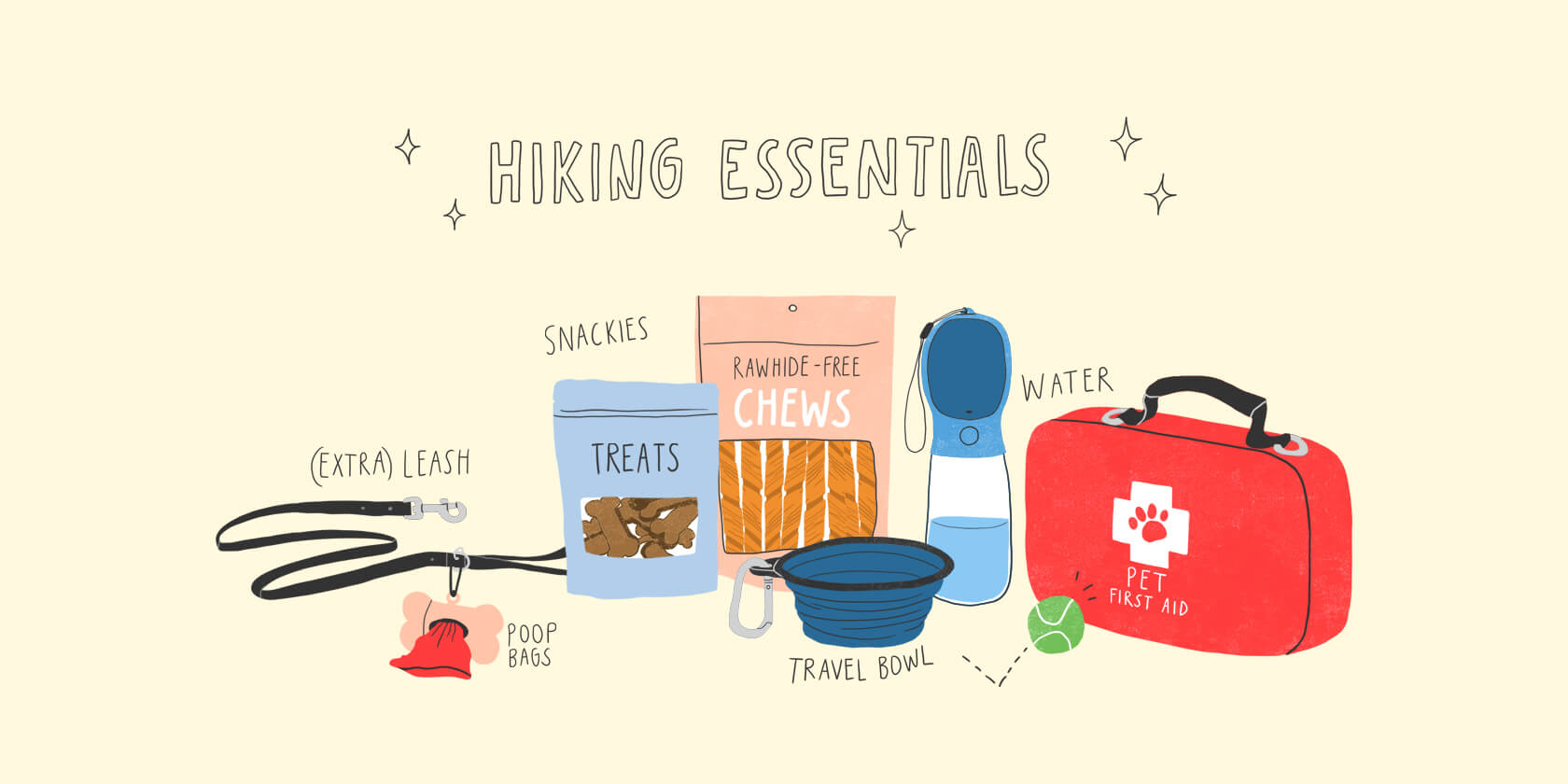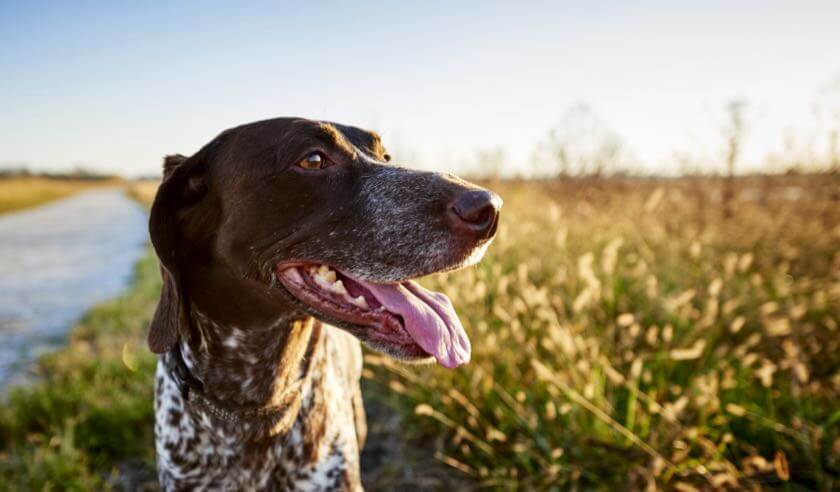Taking your dog along on a hike is a great way to burn some of their physical and mental energy. Getting to sniff and explore a new environment is wonderful mental enrichment for your dog, and enjoying the outdoors is beneficial for your own health, too.
When planning your next hike, it’s important to take steps to ensure your dog’s safety while on the trail. Here are a few tips.
Before You Take Your Dog on a Hike
Health Considerations
Before you start your hike, take into account whether or not your dog is physically capable and up to the task of trail hiking.
Young Dogs
Puppies are at increased risk for heat exhaustion and heat stroke. If your puppy’s bone growth plates haven’t closed yet, strenuous activity can cause physical development problems. It’s best to check with your veterinarian to ensure your puppy is ready to begin hiking.
Older Dogs
Some senior dogs may have a limited capacity for strenuous exercise. They may be suffering from the pain of osteoarthritis or have other conditions that could increase injury risks that hinder their mobility. A long hike might be too much for them to handle.
Brachycephalic (Short-Nosed) Breeds
Bulldogs, Boxers, Frenchies, and other smush-faced dogs are prone to exhaustion and heat stroke. This is due to their narrow nostrils and other factors that make it more difficult for them to breathe and control their body temperature. Watch carefully for excessive panting, a dark purple tongue, staggering, or slowing down in your dog.
Before you go on a hiking adventure, ask your veterinarian if your dog is physically ready and able to hit the trails.
Vaccinations Matter
Your dog should be up-to-date on their vaccinations before going on a hike. Check with your veterinarian whether your dog needs additional vaccinations to protect against illnesses or hazards that they might not regularly be exposed to, such as leptospirosis, rabies and Lyme.
Parasite Preventatives
Hopefully, you already have your dog on preventative medication for fleas, ticks, and heartworm. This is especially important when you’re planning on taking them out into the wilderness.
Training Considerations
Off-Leash
Does your dog have good impulse control? Would they respond to “Sit”, “Stay”, “Come”, and “Heel” while out with you on the trail (or if they spot a rabbit or squirrel)? These skills are imperative for the safety of your dog, other hikers, and other animals you might encounter while hiking. If your dog isn’t quite up-to-snuff on these skills, practice until you feel more confident that you can be a polite outdoor enthusiast. Otherwise, always keep them on-leash.
On-Leash
Even if your dog is well-behaved and responsive off leash, it’s always best to keep your dog on a leash while hiking. This isn’t just for their own health and safety (falling off cliffs, eating poisonous mushrooms, startling and getting attacked by a porcupine, etc.), but also so that other hikers feel more comfortable, to protect wildlife from disruptions, and to reduce damage to the natural habitat. A long leash (think 10 – 15 feet) allows your dog the freedom to explore without actually being off-leash.
Getting Them Ready for a Hike
Once you’ve gotten the okay from your veterinarian, you’ll want to build up your dog’s stamina to prevent injury before hitting the trails. Start with a short and easy hike and gauge their energy level throughout and afterward. If they seem exhausted, lessen the length and difficulty of the hike and slowly build up from there. If they seem to recover well, slowly add more length and difficulty to your hikes.
Make sure your dog has a well-fitting collar with their rabies tag and identification tag intact. Having your dog microchipped is also a great safety precaution. If they’re already microchipped, make sure it’s been registered and that your contact information associated with it on the registry is up-to-date. It’s easy to check if your microchip is up-to-date.
Where to Hike
Choosing a Trail
Find a hiking trail that matches your dog’s physical capabilities. A website like AllTrails can help you find trails where dogs are allowed and what the rules are. Rocky terrain can be tough on your dog’s feet and paws (doggie boots may help), and steep cliffs or drop-offs along a trail can be a disaster waiting to happen!
Trail Etiquette
It’s really important to pick up your dog’s poop while on a hike. Dog poop is not natural to the area you’re visiting, and as such, it can disrupt natural fauna and can introduce pathogens and parasites into the environment.

What to Bring On the Hike
Be prepared by having the following hiking supplies for your dog:
- Water and Water Bowl
Fresh drinking water will keep your dog hydrated. - Snacks for Your Dog
Keep your dog’s energy up for their time on the trail with snacks. - Dog First-Aid Kit
Be prepared for a trail-related injury with a first-aid kit. - Poop Bags
Pick up your dog’s poop and leave no trace. - Extra Leash
Use an extra leash to secure your dog to a tree, or use if your main one breaks.
Optional hiking gear for your pup:
- Doggie Boots
These will protect your dog’s paws, especially when hiking on rocky terrain. The ground may be too hot, and these can help keep dogs from getting their feet burned. As a rule of thumb: if you can’t keep your hand on the ground or pavement for more than 5 seconds, then the ground is probably too hot for your dog to walk on. - Sunscreen or Sun-Protective Clothing
Protect their skin from the sun’s harsh rays. This is especially important for dogs with light skin or white hair. - Dog Hiking Backpack
Let your dog carry their gear on the trail.
You’re now ready to hit the trails with your dog! Following your hike, remember to check your dog for ticks, foxtails, and cuts on their paws, between their toes, and around their ears.
ZPC-00208R2





